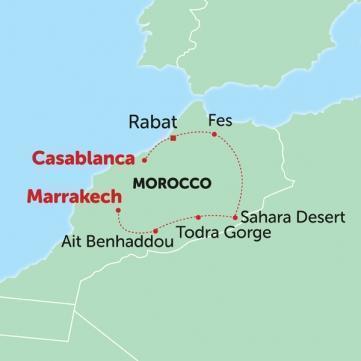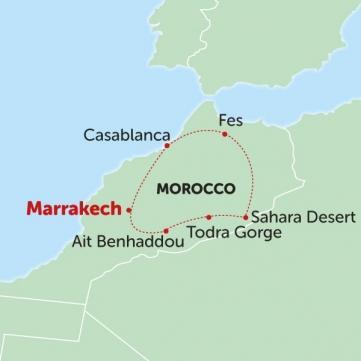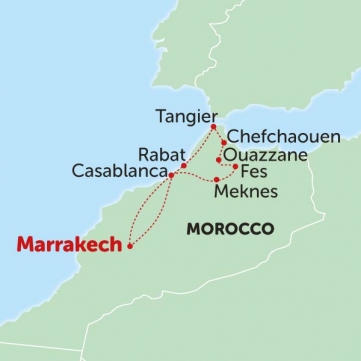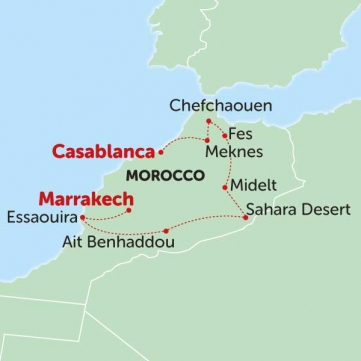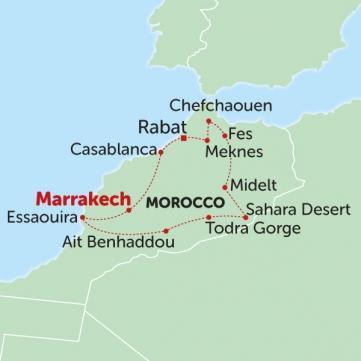Book NOW for $1 £1 €1 • Flexible Payments • No Change Fees • Private Departures Available
- Home >>
- Destinations >>
- North Africa & The Middle East >>
- Morocco
Morocco Tours
Warmed by the North African sun, our Morocco adventure tours offer the chance to explore this fascinating country with a North Atlantic and Mediterranean coastline, combined with a vast Saharan desert interior and a long ridge of the Atlas Mountains. With a rich heritage of nomadic Berbers, Roman conquerors, Muslim Arabs and French colonialists, Morocco boasts more than its fair share of cultural treasures. During your Morocco adventure tour you can take a camel trek into the desert and camp under the stars, discover the cosmopolitan coastal town of Casablanca with its art deco city centre and lose yourself in the labyrinthine markets of the medieval medina of Fez before a visit to its vibrantly coloured dye pits. Explore the ancient citadels and wild beaches of Essaouira and take in the awe inspiring natural wonder of Todra Gorge with its 250 metre high sheer rock faces. Trace the remnants of Roman civilisation at the ruins of Volubilis and witness the devilish charisma of the snake charmers and storytellers of Marrakesh. Enjoy a Morocco adventure tour with us and discover the many faces of this extraordinary land.
All Tours of Morocco
5 Tours
Independently Verified Travel Reviews From Past Clients
Morocco Travel Guide
Morocco Travel Guide
Brief history
Morocco's early inhabitants were Berber-speaking nomads; many of these became followers of Christianity and Judaism, which were introduced during a brief period of Roman rule. In the 16th century, Ottoman invaders from Algeria attempted to add Morocco to their empire, thus threatening the country's independence. They, too, were thwarted, leaving Morocco virtually the only Arab country never to experience Ottoman rule. This decisive battle, claimed as a Moroccan victory, put an end to European incursions onto Moroccan soil for three centuries.
The 17th century saw the rise of the 'Alawite dynasty of sharifs, who still rule Morocco today. This dynasty fostered trade and cultural relations with sub-Saharan Africa, Europe, and the Arab lands, though religious tensions between Islam and Christendom often threatened the peace. Morocco was also unique among the North African countries in possessing a coast on the Atlantic.
By the early 20th century, Europe's influence in Morocco was formalised with the 1912 Treaty of Fez, making Moroco an official protectorate of France, and to a lesser extent Spain. The negligible role that the Moroccan government (makhzan) actually played during this periond can be seen by the fact that Muhammad al-Moqri, the grand vizier when the protectorate was installed, held the same post when Morocco recovered its independence 44 years later; he was by then more than 100 years old. As in Tunisia, country districts were administered by contrôleurs civils, except in certain areas such as Fez, where it was felt that officers of the rank of general should supervise the administration. In the south certain Berber chiefs qa'ids, of which the best known was Thami al-Glaoui, were allowed to remain semi-independent.
In 1956, the Spanish authorities were taken by surprise when the French decided to grant independence to Morocco. A corresponding agreement with the Spanish was nevertheless reached on April 7, 1956, and was marked by a visit of the sultan to Spain. The Spanish protectorate was thus brought to an end without the troubles that marked the termination of French control. With the end of the Spanish protectorate and the withdrawal of the Spanish high commissioner, the Moroccan khalifah, and other officials from Tétouan, the city again became a quiet, provincial capital. The southern protectorate area of Tarfaya was handed back to Morocco in 1958, while the Spanish unconditionally gave up Ifni in 1970, hoping to gain recognition of their rights to Melilla and Ceuta. Ceuta, on the Strait of Gibraltar, and Melilla, farther east on the Mediterranean coast, continue to be Spanish presidios on Moroccan soil, both with overwhelmingly Spanish populations. In October 1978 the United States turned over to Morocco a military base, its last in Africa, at Kenitra.
Geography and weather
July and August are the hottest months and can be wonderful on the coast, while in the mountains there are no set rules. Spring, which comes late by European standards (around April to May), is perhaps the best overall time, with a summer climate in the south and in the mountains, as well as on the Mediterranean and Atlantic coasts. Winter can be perfect by day, in the south, though be warned that the nights are extremely cold.
Visit www.worldclimate.com to get an idea of what the weather will be like on your tour.
Visas
All nationalities require a visa to enter Morocco and conditions differ with respect to individual nationalities. For the latest information on your specific visa requirements you should contact your local Moroccan Embassy or Consulate. Visas are usually valid for three months from the date of issue and are valid for multiple entry regardless of whether you intend staying that long or re-entering the country.
Visa services like www.travcour.com can be very helpful.
Money
The monetary unit in Morocco is the Moroccan dirham, MAD. For up to date exchange rates with your own currency visit www.oanda.com or www.xe.com.
In most cities you will find banks, and you will be able to exchange cash and travellers cheques. ATMs are present in major cities as well, but credit cards are usually only accepted in large shops, hotels, expensive restaurants etc. You should take either US dollars or pounds sterling as travellers cheques as these are the easiest to exchange (however if this is not possible other currencies are accepted).
Tipping
Although tipping may not be a custom to you at home, locals in Morocco depend on your tips. Tucan Travel aims to support the local community on every tour by staying in locally operated hotels and employing local guides for many excursions. However, tips are one of the most important aspects of our contribution to local communities. We operate a tipping kitty which is to be paid locally to the tour leader in US dollars on day one of the tour, to ensure that all locals who offer the group a service whilst on the tour, are tipped in the usual way. For the tipping kitty appropriate to your own tour, please see the 'Tour Dossier' tab of your tour on the website, and look for the section entitled 'Tipping Kitty'. Please note that this tipping kitting does not include a tip for your tour leader. We suggest a tip of 2-3 US$ per day, to be paid at the end of your tour, however this is completely at your own discretion.
Security
Most people find that Morocco is a very safe and friendly country but in any foreign place you should exercise a reasonable degree of caution. Be sensible (NOT paranoid). Don’t walk around lonely back streets, especially on your own or at night, don’t wear expensive looking jewellery or a classy watch and don’t carry a wallet in your back pocket. Don’t carry your camera openly; always have it in a small day pack which is firmly attached to your body, preferably in the front in crowded places. Take particular care not to become too relaxed if you have had a few drinks and are returning to your hotel at night – it is best to always take a taxi. Always wear a money belt or leave your valuables, including your passport, in the hotel security box.
Local food and drink
Evening meals and lunches will generally be eaten in local restaurants. Please see your tour notes for details about any included meals.
Your tour leader will take you to local restaurants so you can taste the varied local cuisine! Moroccan dishes are widely varied and combinations of spices give each city and region distinct flavours.
Morocco produces a large range of Mediterranean fruits and vegetables and even some tropical ones. The country produces large quantities of sheep, poultry, cattle, and seafood which serve as a base for the cuisine. Spices are used widely and even though spicy dishes are widely available, mild can easily be found. Spices include saffron from Tiliouine, mint and olives from Meknes, and oranges and lemons from Fez, are home-grown. The main Moroccan dish most people are familiar with is couscous which is very old and is probably of Berber origin.
All drinks such as bottled water or soft drinks are at your own expense at all times and are fairly inexpensive. Water from a tap or well should not be considered safe to drink. Bottled water, carbonated soft drinks and fruit juices are widely available throughout the country. Alcoholic drinks vary in price, with beer generally being the cheapest option.
The most popular drink is green tea with mint. Traditionally, making good mint tea in Morocco is considered an art form and the drinking of it with friends and family members is one of the important rituals of the day. The technique of pouring the tea is as crucial as the quality of the tea. The tea is accompanied with hard sugar cones or lumps. Moroccan tea pots have long, curved pouring spouts and this allows the tea to be poured evenly into tiny glasses from a height. To acquire the optimum taste, glasses are filled in two stages. The Moroccans traditionally like tea with bubbles, so while pouring they hold the teapot high above the glasses.
Time Difference
The time difference in Morocco is GMT/UTC + 0. For other time differences please visit www.timeanddate.com
Voltage
127/220 volts - 50 Hz. Sockets are of European two pronged round pin variety



